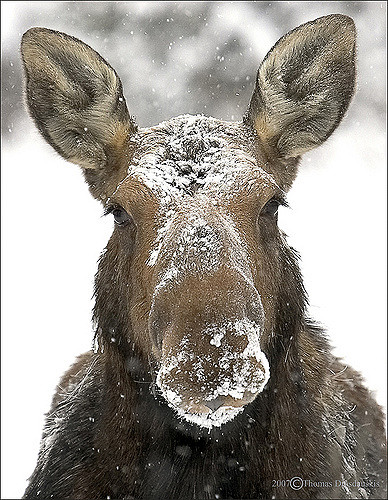Moose on the Move

Written by Gabe Allen.
A string of late season storms have meant a longer than usual winter in Northern Vermont this year. Although in mid-April there was still over 7 feet of snow on Mount Mansfield, down here in Burlington the snow retreated to small swaths around tree roots and recesses in hollowed out stumps. Tulip shoots are rising up beside the sign for the UVM medical center, the maples and birches that line the city streets are full of buds, and sunset on Lake Champlain has been pushed back to well after dinnertime. As springtime arrives in Vermont many animals will reappear from their hiding places. Bears will awake from hibernation, salamanders will converge in vernal pools to mate, and yearling moose, shooed away by their calving mothers, will wander down from the highlands.
Over the years, a few of these wandering young moose have made there way into Burlington. Notably, in April of 2013, A young moose led police and game wardens to a shed in the South End that was home to an illegal marijuana growing operation. In May of the next year, another moose came into Burlington via the Winooski river, kicked out a window in a UVM academic building, and then proceeded on an adventure through the city that inspired a twitter account called @BTVMoose.
According to Michael Kessler, a UVM professor of forensic tracking, during the 1990’s and 2000’s you could expect to see a wandering moose somewhere in the city almost every other year. During that time he tracked many moose on their travels through the city, and he started to see patterns in where they came from, where they were going, and where they stopped along the way.
According to Michael, the moose usually come into the city along the Winooski river and head up a small drainage by the Cumberland farms on River Street. Their next stop is almost always a patch of old-growth pine forest next to the cemetery at Mount Saint Mary’s convent. He suggests that the moose are drawn to this patch of forest because of their spiritual and ancestral connection to the trees there. An aerial picture of Burlington also reveals that the cemetery is adjacent to a continuously forested swath of land that stretches from River Street up to the UVM campus. It is the last stretch of forested land that a moose would encounter on their way down the West side of the Winooski.
This is likely the route that the moose from @BTVMoose took on its way up to the UVM campus. After this, the moose no longer had trees for cover and started to encounter Burlington’s human inhabitants. Michael says that the path it followed next connected with a number of other patches of old growth forest in the city. Where there were no trees, it gravitated towards other tall objects like telephone poles and signs for cover.
Whether or not you believe in spirits, one cannot deny that moose, on an individual and ecological level, are inexorably linked with trees. They rely on the forest for both shelter and sustenance. In the mid to late 19th century Vermont was largely deforested for farmland, pasture, and timber. In addition the beaver population was mostly eliminated due to unregulated trapping. This resulted in a sharp decrease in two important food sources for moose: the aquatic plants that thrive in beaver ponds and buds and shoots from new growth on trees. This combined with unregulated hunting caused the near extinction of the Vermont moose by the mid 19th century. In the 1960s Vermont Fish and Wildlife estimated that there were only 25 moose in Vermont, and they were all within Essex county.
New management plans across New England, the return of Vermont’s forests, and a ban on moose hunting saw the return of a large population over the next five decades. In 2007, Vermont Fish and Wildlife estimated a population of 4,000 individuals.
Now, moose face a new problem in New England. Vermont moose are again on the decline due, for the most part, to a massive increase in winter tick loads (Dermacentor albipictus). Unlike deer ticks, albipictus stay on the same host throughout their development from the larval stage to adulthood. In the springtime, they dismount their host to lay eggs. A thinner snowpack in recent years has meant that these ticks more often land on dry ground and survive long enough to lay eggs. Moose are at a disadvantage when it comes to fending off albipictus because they are solitary and do not regularly groom them off like deer. It is now not uncommon for an individual moose to have tens of thousands of ticks feeding on their blood at once. This combined with scarce food in the winter and other parasites can lead to anemia, starvation, and ultimately death. According to a study born out of collaboration between VT Fish and Wildlife and UVM, calf mortality was at 40% for Vermont moose between March and April last year. Many of these deaths were linked to stress from high winter tick loads.
Keep your eye out for long-legged ungulates in the coming month. Although moose are suffering right now, the population is still large. Barring some ecological or technological innovation that allows us to decrease winter tick loads, Burlington may be seeing less and less of them in the coming years. For the moose’s sake, I hope that none wander into our city this spring. I cannot deny, though, there is something wild and exciting about living in a place where you could turn a corner and bump into a moose.
